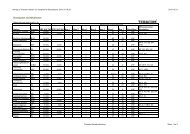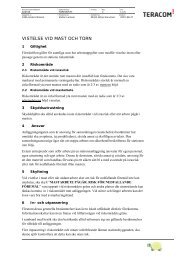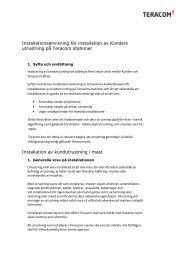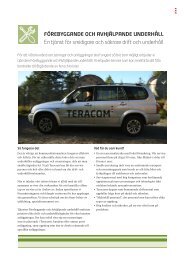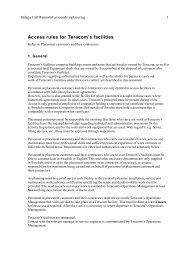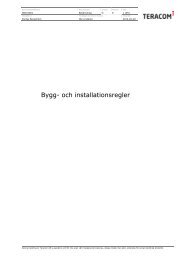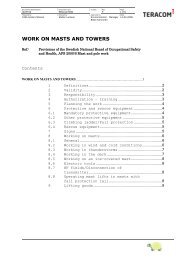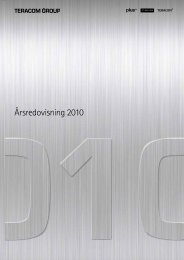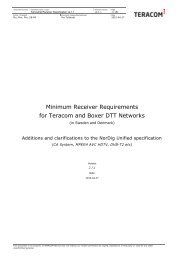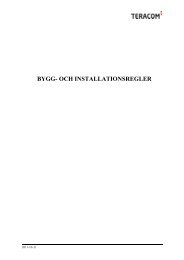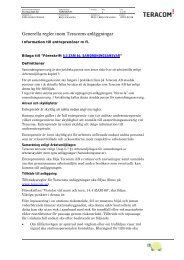Annual and Sustainability Report 2011 - Teracom
Annual and Sustainability Report 2011 - Teracom
Annual and Sustainability Report 2011 - Teracom
You also want an ePaper? Increase the reach of your titles
YUMPU automatically turns print PDFs into web optimized ePapers that Google loves.
No major changes will be made for financial liabilities compared to IAS 39.<br />
The most significant change relates to liabilities identified at fair value. The<br />
portion of the change in fair value that is attributable to the credit risk of the<br />
liability should be reported in Other comprehensive income instead of profit<br />
or loss as long as this does not create a recognition inconsistency (accounting<br />
mismatch). The Group intends to apply the new st<strong>and</strong>ard no later than the<br />
financial year starting 1 January 2013 <strong>and</strong> has not yet evaluated the effects.<br />
The st<strong>and</strong>ard has not yet been adopted by the EU.<br />
IFRS 10 Consolidated Financial Statements: This st<strong>and</strong>ard defines the term<br />
"deciding influence" <strong>and</strong> builds on existing principles by identifying controls<br />
as the determining factor in whether a company should be included in the<br />
consolidated financial statements. The st<strong>and</strong>ard provides additional guidance<br />
to assist in the determination of control where this is difficult to assess.<br />
Given the current ownership structure of the Group, the new st<strong>and</strong>ard will<br />
not affect the Group's reporting. IFRS 10 enters into force on 1 January 2013<br />
but has not yet been adopted by the EU.<br />
IFRS 12 Disclosures of Interests in Other Entities: The st<strong>and</strong>ard covers disclosure<br />
requirements for subsidiaries, joint arrangements, associated companies<br />
<strong>and</strong> unconsolidated structured entities. The Group intends to apply IFRS 12<br />
to the financial year starting 1 January 2013 <strong>and</strong> has not yet evaluated the<br />
full effect on the financial statements. IFRS 12 enters into force on 1 January<br />
2013 but has not yet been adopted by the EU.<br />
IFRS 13 Fair Value Measurement: The purpose of the st<strong>and</strong>ard is to make the<br />
fair value measurements more consistent <strong>and</strong> less complicated by providing<br />
an exact definition <strong>and</strong> a single source within IFRS for fair value measurements<br />
<strong>and</strong> related disclosures. The requirements do not exp<strong>and</strong> the area of<br />
application for when fair value should be applied, but rather provide guidance<br />
with regard to how it should be applied when other IFRS already require or<br />
allow fair value measurements. The Group has not yet evaluated the full effect<br />
of IFRS 13 on the financial statements. The Group intends to apply the new<br />
st<strong>and</strong>ard to the financial year starting 1 January 2013. The st<strong>and</strong>ard has not<br />
yet been adopted by the EU.<br />
Use of estimated values<br />
In the preparation of the annual report in accordance with IFRS, Group management<br />
has used assumptions <strong>and</strong> estimates in the reporting of assets <strong>and</strong><br />
liabilities. Discussed below are those areas where there is the greatest risk for<br />
changes in value during the following year due to a potential need to revise<br />
prior assumptions or estimates.<br />
Transactions with minority owners<br />
The <strong>Teracom</strong> Group owns a majority of the shares in the Finnish pay TV operator,<br />
Digi TV Plus Oy. In conjunction with the acquisition in 2009, <strong>Teracom</strong> also<br />
issued a put option over the remaining minority shares <strong>and</strong> <strong>Teracom</strong> also has<br />
a call option to acquire the same shares. The commitment related to the put<br />
option is included in the total acquisition cost. The liability was reported at<br />
fair value based on <strong>Teracom</strong>'s best assessment of what it will have to pay for<br />
the outst<strong>and</strong>ing equity stake. The future payment of the outst<strong>and</strong>ing equity<br />
stake is based on the company's future results <strong>and</strong> it may be adjusted if the<br />
assumptions underlying <strong>Teracom</strong>'s assessment change. The option's interest<br />
rate effect <strong>and</strong> currency effect are reported in the income statement on an<br />
ongoing basis.<br />
Impairment of assets<br />
Non-current asset such as goodwill are reviewed each year to determined<br />
the impairment requirement or when events <strong>and</strong> changes occur that indicate<br />
the carrying amount of an asset cannot be recovered. Company management<br />
regularly conducts a revaluation of the useful life of all tangible <strong>and</strong><br />
intangible assets. It is the opinion of the company's management team that<br />
reasonable changes to the factors forming the basis for the estimation of the<br />
assets' recoverable amounts would not result in the carrying amount exceeding<br />
the recoverable amount.<br />
Accounts receivable<br />
Receivables are reported net after reserves for doubtful debts. The amount<br />
is based on circumstances known at the balance sheet date. Changed conditions,<br />
for example that payments in default increase in scope or the financial<br />
position of a significant customer changes, can result in significant deviations<br />
from the valuation.<br />
Post-employment remuneration<br />
The <strong>Teracom</strong> Group has both defined benefit pension plans <strong>and</strong> defined contribution<br />
pension plans. The defined benefit plans entail actuarial risk <strong>and</strong><br />
investment risk for the Group. Actuarial calculations of pension commitments<br />
<strong>and</strong> pension expenses are based on a number of assumptions, such as the<br />
discount rate, anticipated salary increases, anticipated remaining periods of<br />
employment <strong>and</strong> anticipated return on plan assets. A change in any of these<br />
fundamental assumptions could have a significant impact on calculated pension<br />
commitments, financing requirements <strong>and</strong> pension expenses.<br />
Restructuring costs<br />
Restructuring costs include required impairment of assets <strong>and</strong> other items<br />
that do not affect the cash flow, such as estimated costs for notices of termination<br />
<strong>and</strong> other direct costs related to the phasing out of operations. The<br />
cost calculation is based on detailed action plans that are expected to improve<br />
the Group's cost structure.<br />
Accounting principles for the Parent Company<br />
The Group’s <strong>and</strong> the Parent Company's financial statements <strong>and</strong> terminology<br />
differ since the Group applies IAS 1 <strong>and</strong> the Parent Company applies RFR 2<br />
September <strong>2011</strong> <strong>and</strong> the <strong>Annual</strong> Accounts Act (1995:1554). The Parent Company<br />
is limited in its ability to fully apply IFRS. These limitations are associated<br />
with the Parent Company's application of RFR 2, the <strong>Annual</strong> Accounts Act <strong>and</strong><br />
the Parent Company's tax regulations.<br />
Participations in subsidiaries<br />
Participations in subsidiaries are reported in accordance with the cost method.<br />
The value of the participations is tested when there are indications that<br />
the value has depreciated.<br />
Anticipated dividends<br />
Dividends from Group companies are reported in the income statement after<br />
a decision regarding dividends is made at each subsidiary's <strong>Annual</strong> General<br />
Meeting. Anticipated dividends are reported when the Parent Company unilaterally<br />
has the right to decide on the size of the dividends <strong>and</strong> the Parent<br />
Company has decided on the size of the dividends before it published its<br />
annual report or quarterly reports.<br />
Shareholder contributions <strong>and</strong> Group contributions<br />
Group contributions paid from the Parent Company to subsidiaries are reported<br />
in the Parent Company in the same manner as shareholder contributions.<br />
Shareholder contributions are reported directly against the recipient's equity<br />
with a corresponding increase in "Participations in Group companies" by the<br />
contributor. Alternatively, the Group contribution may be reported as a cost in<br />
the income statement. Group contributions received from subsidiaries should<br />
always be reported in the Parent Company as financial income in the same<br />
manner as a dividend.<br />
Leases<br />
All lease agreements are reported in the Parent Company according to the<br />
rules that apply for operating leases.<br />
Valuation of financial instruments<br />
Unlike the Group, the Parent Company does not adjust financial instruments<br />
to fair value.<br />
Deferred taxes<br />
The <strong>Teracom</strong> Group's deferred tax assets are primarily attributable to loss<br />
deductions <strong>and</strong> temporary differences <strong>and</strong> these are reported if the tax assets<br />
are expected to be recoverable via future taxable income. Changes to the<br />
assumptions regarding future taxable income, or changes to tax rates, can<br />
lead to significant changes in the valuation of deferred taxes.<br />
71



